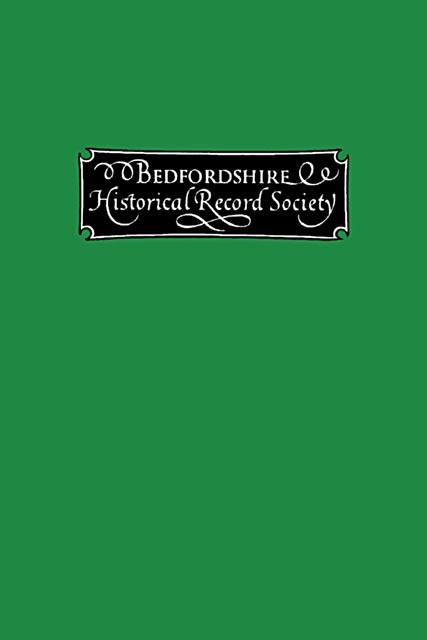Book contents
- Frontmatter
- Contents
- Abbreviations and Symbols
- Stagsden and its Manors
- Three Records of The Alien Priory of Grove And The Manor of Leighton Buzzard
- Ancient Bedfordshire Deeds. III
- Harlington Churchwardens’ Accounts
- Some Bedfordshire Assessments for The Taxation of a Ninth (1297)
- Institutions to Ecclesiastical Benefices in The County of Bedford, 1535-1660
- Notes
- Corrigenda Noticed in The Previous Volumes Published by The Society
- Index
Institutions to Ecclesiastical Benefices in The County of Bedford, 1535-1660
Published online by Cambridge University Press: 18 July 2023
- Frontmatter
- Contents
- Abbreviations and Symbols
- Stagsden and its Manors
- Three Records of The Alien Priory of Grove And The Manor of Leighton Buzzard
- Ancient Bedfordshire Deeds. III
- Harlington Churchwardens’ Accounts
- Some Bedfordshire Assessments for The Taxation of a Ninth (1297)
- Institutions to Ecclesiastical Benefices in The County of Bedford, 1535-1660
- Notes
- Corrigenda Noticed in The Previous Volumes Published by The Society
- Index
Summary
The post-Reformation episcopal registers at Lincoln for the period 1545 to 1660 have many lacunae, and the calendar which is printed below will serve in some measure to supply the institutions to ecclesiastical benefices which are now missing. In that period, the diocese consisted of the counties of Lincoln, Leicester, Bedford, Buckingham, Huntingdon, and part of Hertford.
The calendar is compiled from three classes of documents which are preserved in the Public Record Office in London :—(a) the Composition Books, which relate to the payment of first fruits; (b) the Bishops’ Certificates of the diocese of Lincoln; and (c) the Bishops’ Certificates of the diocese of Canterbury.
THE COMPOSITION BOOKS.
First fruits were originally a payment which was made to the pope by a clergyman upon his presentation to an ecclesiastical benefice. The payment consisted of the first year's income of the benefice. Tenths were a yearly payment made to the pope of one tenth part of the annual value of the benefice. The reason alleged by the canonists for the exaction of these payments to the pope, was, ‘pro conservando decenti statu suo, ut qui omnium curam habet de communi alatur.’ Black-stone says that these payments were first introduced by the papal legate, Pandulph, in the diocese of Norwich, and afterwards extended to the whole kingdom. First fruits and tenths were charged according to a valuation of ecclesiastical benefices, made about 1291-2, which is known as the Taxation of Pope Nicholas (printed by the Record Commission in 1802).
When the jurisdiction of the pope over the Church of England was extinguished in the time of Henry VIII, first fruits and tenths were taken away from the pope (25 Henry VIII, cap. 20); and given to the crown (26 Henry VIII, cap. 3). Under the latter statute, in 1535, a new valuation of benefices was made by royal commissioners, which is known as the Valor Ecclesiasticus (printed by the Record Commission, six volumes, 1810- 1834), by which incumbents of benefices are still rated for first fruits and tenths. Upon presentation to a benefice, a person was required to compound for the first fruits, arranging for payment by suitable instalments, and finding sufficient sureties for the payments. If the benefice were worth less than eight marks a year, and the incumbent died within three years, his bond to pay was to become void (ibid.).
- Type
- Chapter
- Information
- The Publications of the Bedfordshire Historical Record Society , pp. 133 - 164Publisher: Boydell & BrewerFirst published in: 2023

